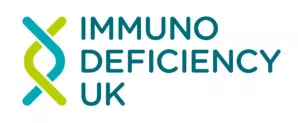What is secondary immunodeficiency?
Secondary immunodeficiency (SID) occurs when the immune system is weakened by another treatment or illness. The signs and symptoms of SID are the same as for primary immunodeficiency; that is, frequent, prolonged or unusual infections. If the underlying cause can be removed, then in many individuals the immune system returns to normal. For others, this is not the case and the treatment is long-term, even life-long.
Causes of secondary immunodeficiency
There are many potential causes of SID but the most common examples are blood or bone marrow disorders, drugs (medicines) and treatment for cancer. Some cancers can be responsible for SID, too. The main medicines that cause problems are those that target the immune system, including immunosuppressant drugs, ‘biologics’ and chemotherapy. These medicines may have been used in the treatment of conditions such as rheumatoid arthritis, multiple sclerosis, inflammatory bowel disease and psoriasis, and of blood and lymph node cancers in particular.
There are other medicines that are recognised as causing specific complications with the immune system and these effects are not directly related to the way the drug works. For example, some anti-epileptic drugs can cause antibody deficiency. There are some rare, inherited medical problems, such as transcobalamin deficiency and gut lymphangiectasia, that are not immune deficiencies but cause failure of antibody production or loss of antibodies from the gut. These causes can be treated and/or replacement immunoglobulin therapy given. Although HIV infection is a cause of secondary immunodeficiency, this is usually treated as a separate problem in its own right. However, it is often something that doctors wish to exclude before considering other causes for primary or secondary immunodeficiency.
Symptoms and diagnosis
The signs and symptoms of SID are the same as for primary immunodeficiency; that is, frequent, prolonged or unusual infections. Tests are usually necessary to understand what the problem may be.
Blood tests are used to test for SID. The precise tests of immune function will depend on the type of infections that have been a problem. It may be that you have low numbers of neutrophils. This can easily be detected by repeating a full blood count on several occasions. Or, it may be that you aren’t making enough antibodies. Other, more subtle, immune defects may require blood tests that are a little more complicated from a laboratory point of view, however, these will only require a few blood samples from you.
Treatments
The treatment you will be recommended depends on the nature of the secondary deficiency. If ongoing treatment is thought to be the cause, then the treatment may be changed or removed. If another disease is the cause, then treating it may resolve the immunodeficiency.
Here we summarise the treatments that are used for different types of secondary immunodeficiency.
Will my treatment be life-long?
If the underlying cause cannot be removed or resolved, then the treatment is supportive, with anti-viral drugs (where appropriate), antifungals and/or antibiotics.
If the underlying cause can be removed, then in many individuals the immune system returns to normal. For others, this is not the case, and the treatment is long term, even life-long.
Your immune system will be regularly monitored to determine if you need continuing treatment.





